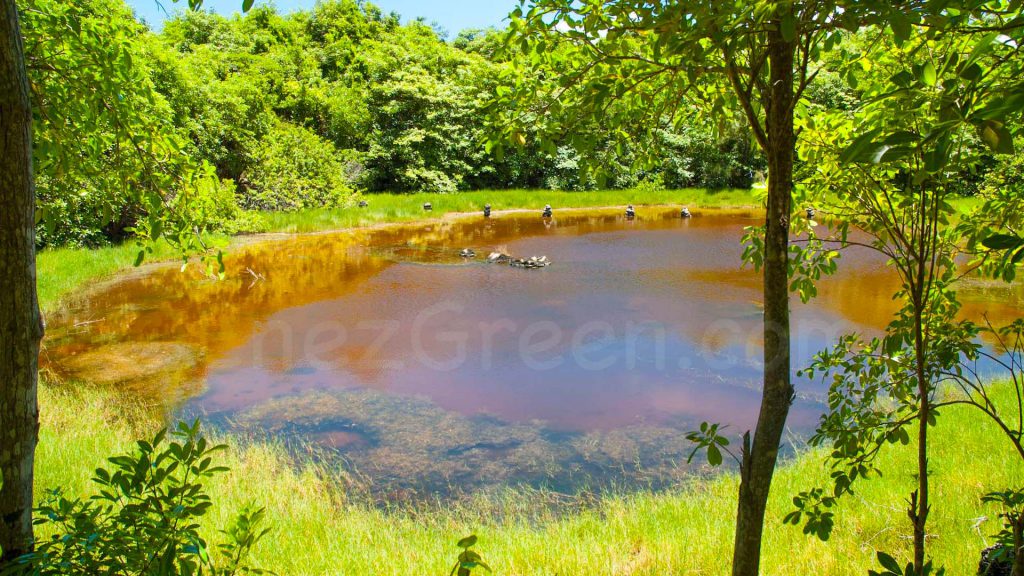Entering the near-pristine mangrove of Île d’Ambre is akin to discovering Mauritius off the beaten tracks, away from the luxury resorts and the hustle and bustle of tourism. The islet, which forms part of the national parks of Mauritius, is located within the north-eastern lagoon, a few metres away from the coast.
A rehabilitation programme has been carried out on Île d’Ambre
Despite the absence of beaches, Île d’Ambre boasts heavenly scenery, which namely inspired French writer, Bernardin de Saint Pierre. Île d’Ambre is the tragic site of the wreck of the Saint Géran. It also owes its name to the sperm whales that frequently visit the waters around the islet. Indeed, after having consumed massive amounts of their favourite preys, cuttlefish and squids, sperm whales produce a substance called ambergris, which is used to make perfumes. The fact that there are only one or two landing points on this very wild islet, which features beautiful mangrove swamps and thick vegetation, preserves it from mass tourism. A rehabilitation programme has been carried out on Île d’Ambre, which is managed by the Water and Forestry Services and the National Parks Department of Mauritius. Agents have taken years to weed out all invasive plants (flame trees, acacia trees…) before reintroducing indigenous plant and tree species with evocative Creole names such as ‘bois de reinette’ (Dondonaea viscosa), ‘bois chandelle’ (Amyris Wood), ‘bois matelot’ (Surina maritima) and ‘bois boeuf’ (Gastonia mauritiana).
Kayaking through the mangrove swamps
The place has been laid out with local materials and ecological tourism activities embrace an approach that respects the environment. Patrick Haberland has seized the opportunity to offer kayak excursions around the island and through the twists and turns of its mangrove swamps. ‘Sea kayaks are ideal to visit in all tranquillity this unique and fragile ecosystem and to get close to the animals without scaring them away,’ explains the young man, who launched his ecological tourism company in 2000. Yemaya is named after the Yoruba goddess of the sea and aims at enabling participants to learn the magics of nature in fun, adventurous and eco-friendly manner. Patrick Haberland offers sea kayaking trips to various sites around Mauritius. Paddling through the mangrove swamps is a unique experience that enables the discovery of the mangrove tree, a fascinating plant species which holds a vital role in the marine ecological system.
Snorkelling among the mangrove trees
During a snorkelling break, participants can also observe the rich fauna that lives under the water, among the roots of the mangrove trees. ‘These plants represent a refuge, a nursery and feeding place for a number of coral reef fish,’ explains Patrick Haberland while pointing at juvenile pennant coral fish roaming around the roots of a mangrove tree. Snorkellers can come across juvenile soldierfish, sunfish, batfish, and sometimes blacktip reef sharks, while diving along the mangrove trees. ‘You can often see sea turtles as well,’ adds Patrick Haberland, who is a member of Forever Blue. He supports the activities of the association to make an inventory and protect the marine species in the region. A keen ecologist, the kayak specialist seizes any opportunity to sensitise and inform his clients on the fragility of this marine area, as well as on the urgency to preserve its natural environment.
Yemaya the mauritian eco tours’ specialist
It doesn’t take a professional paddler or a top athlete to practise sea kayaking. This activity is accessible to all and is conducted under the supervision of a professional who takes care of every detail for a seamless outing. The single or double kayaks are equipped with a helm system, backrest, as well as storage space and safety equipment. A footpath marked out with basalt rocks crosses the forest filled with exotic sounds and strollers rapidly immerse themselves into a world where Mother Nature rules. One can stop for a while among the veloutier shrubs, coconut trees and blue latan palms to admire a charming little lake before continuing on the track, which leads to the ruins of a house dating from 1750. ‘A family settled on the island shortly after the wreck of the Saint Géran with the intention to plant coconut trees and create a more visible seamark for navigators,’ explains Patrick Haberland. He has dug out photos of his grandparents having a picnic on the islet and is committed to continue the family tradition by offering his clients a snack or lunch with local fruit juice. A way of renewing one’s energy levels to tackle the return trip through the crystal-clear lagoon before landing on the exquisite Melville beach.



